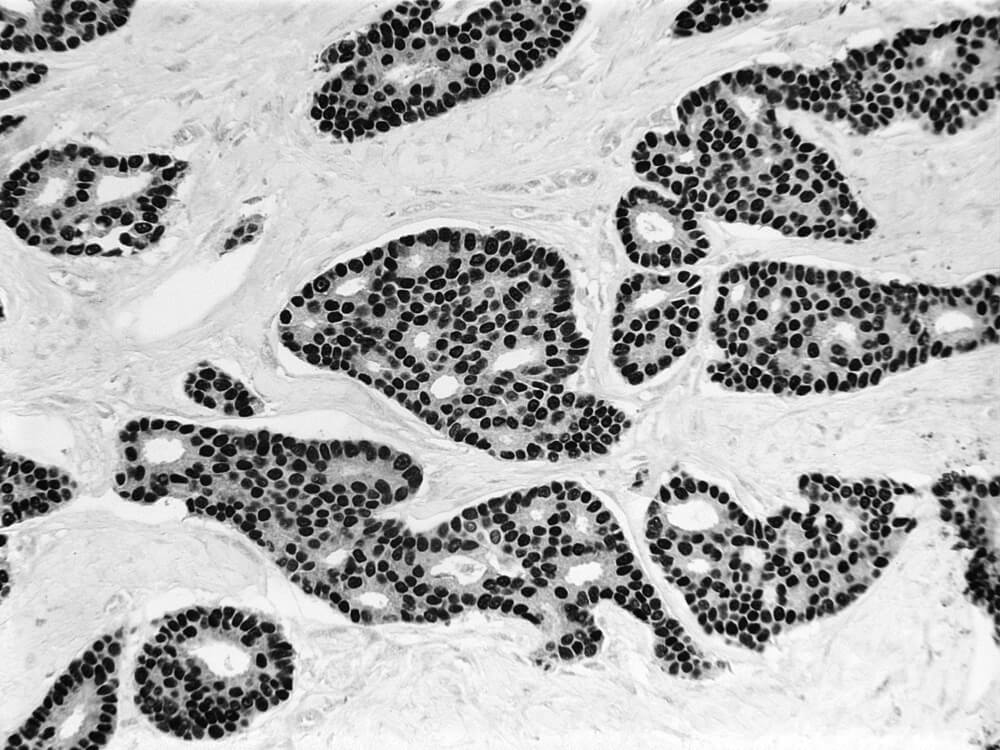When cancer spreads in the body, it is first and foremost due to changes, or mutations, in the DNA of cells. Because of a mutation or other abnormality in a cancer cell’s genome (the DNA stored in its nucleus), the cell may become separated from its neighbors and invade surrounding tissue. Other genomic breakdowns allow the cell to make its way to a nearby blood or lymph vessel, pass through the vessel wall, and ride to another part of the body, where it once again crosses the vessel wall and begins to grow and divide, forming a “secondary” tumor, or metastasis.
The genes that enable tumor cells to break free of their original location and travel to distant sites are part of every cell’s natural endowment. They play a critical role in the early stages of life, allowing cells to move to their assigned positions in the developing embryo or fetus. Eventually, these genes shut down, rendering the cell immobile and helping bind them to their native tissue—be it the lungs, nerves, muscles, or any of the hundreds of other tissue types in the human body. When a mutation or other genetic problem causes the genes to reactivate, tumor cells can gain the ability to move and slip through the spaces between other cells.

Even when cancer cells do break free, their ability to metastasize to other parts of the body is not guaranteed. For one, they may be subject to attack and destruction by elements of the immune system. For another, it takes a variety of genetic alterations to equip tumor cells with the skills needed to pull up stakes and survive in distant tissue: to become unanchored from their home tissue, invade and traverse adjacent tissue, pierce the wall of a blood or lymph vessel, survive a trip in the bloodstream or lymph, make landing downstream, root themselves in a new location, attract blood vessels to draw nourishment, and abide among unfamiliar cells.
Few cancer cells possess all these abilities; most die during their journey through the body. Even when they succeed in settling at a new site, they often remain inactive for many years before beginning to grow again, if at all.
Because metastatic tumor cells have acquired genetic mutations that enable them to survive beyond their place of origin, they may differ, at a molecular level, from cells in the primary tumor. As a result, they may be less vulnerable to drugs that are effective against the tumor. This is one of the main reasons why metastasized cancers are usually more difficult to treat than primary cancers.
The ability to metastasize illustrates cancer cells’ ability to exploit their genetic equipment and surroundings. Genes normally used during fetal development are subverted to enable tumor cells to take up residence outside the original tumor. Blood and lymphatic vessels that carry nutrients, immune system cells, and other critical agents are appropriated by tumor cells as highways to other parts of the body. Substances that normal cells secrete to gain access to blood vessels are hijacked by tumor cells to feed themselves.
Because metastasis involves cancer cells’ ability to make a home in tissue far from the original tumor, a major branch of cancer research seeks to make other tissues inhospitable to breakaway tumor cells. At Dana-Farber, for example, researchers have identified a compound that can potentially prevent multiple myeloma from metastasizing to the bones in animal models. Other research focuses on arming the immune system to prevent metastasis following cancer surgery.

Yes I agree. A very informative article explaining in a manner that is easy to understand. It also proves how complex the metastatic process is and not any one simple factor like sugar as many want to use causes growth. Thank you Dana Farber for this informative article.
Encouraging info on multiple myeloma. We are in a trial now involving a vaccine made from one’s own cancer cells. Thank you all so much for your knowledge and dedication. Special thanks to Kristen, Heidi, Ginger, Tina, Carole, and of course Jacob and the rest of his team. Rooting for Duke in the tourney.
Thank you DF for this update. You managed to give me a easy and concise understanding of Metastasises of the cancer cells. I was diginoused in 2007 with stage 4 lung cancer that quickly metastasised to my bones and lymph nodes. Given just six months to live my Dr. started treating me aggressively with chemo and radiation to no avail. Then I went on a study I had to be taken off the study very early on. With only a miracle left! Well the miracle happened It will be 13 years in April!!! I humbly thank “my Dr.” Dr. Bruce Johnson and his wonderful team. I also would like to thank The Magical Zakim Center crew for all the amazing alternative therapies they offer most of them free!!! Also for the love and compassionate care they continue to give me. Thank you all for helping me suit up every day and fighting the battle. Winning
This is wonderful blog. I was diagnosed in September 2018 with Stage IV lung cancer that methasized in both lungs, lymph nodes and brain. The tumors are shrinking also so I’m hopeful. Thank you for this great group to share. This is the first time I’ve shared my journey